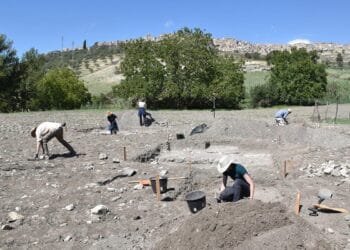A rare Australian Aboriginal knife with a highly polished resin handle has been the subject of a comprehensive investigation to determine its origin and age.
The knife was selected for display in the “The Invisible Revealed” exhibition at the Powerhouse Museum from 2021 to 2022. Given the limited knowledge about the blade’s origin and use, the Powerhouse Museum approached the analysis with caution and adherence to cultural protocols.

To study the knife’s materials without physically handling it, the artifact was sent in a closed box to senior instrument scientist Dr. Joseph Bevitt at the Australian Synchrotron.
The study was conducted in collaboration with the Australian Nuclear Science and Technology Organisation (ANSTO), utilizing non-invasive nuclear and accelerator techniques to shed light on the knife’s history and cultural significance.
Through the use of a non-invasive 3D imaging technique called tomography, the powerful X-ray analysis was able to penetrate the closed box and reveal crucial information about the materials used in the knife’s construction.
The examination determined that the object was not made of metal but rather a dense bone, which narrowed down the potential sources to the Australian cassowary and the water buffalo. As the knife was found in northern Queensland, it was concluded that the bone material originated from the cassowary.
Another aspect of the investigation focused on the radiocarbon dating of the red Abrus seeds found on the knife’s handle. The seeds were analyzed at the Center for Accelerator Science at ANSTO, and the results suggested that the seeds were likely harvested between 1877 and 1930, possibly indicating the timeframe of the knife’s production.
The handle of the knife, adorned with seeds of the Abrus Precatorius plant, indicates its potential cultural significance.
While Leilira knives, commonly used for hunting and as spearheads, are typically made from stone, this particular knife exemplifies the First Nation Australian use of bone, specifically cassowary casque, in the creation of cultural artifacts. The casque has been intricately carved into three-faceted, triangular sections.
The Powerhouse Museum believes that the resin used to create the handle was likely derived from a native plant in the Northern Queensland region. Although the exact identification of the resin was inconclusive through ANSTO testing, it was determined to be an organic material, potentially beeswax.

The artifact, which entered the museum’s collection in 1941 without provenance, provides valuable insights into First Nation Australian craftsmanship and the utilization of bone materials. It deviates from the common stone composition found in Leilira knives, emphasizing the significance of regional variations in indigenous tool production.
As part of the exhibition, the knife was displayed alongside 3D visualizations and other imagery that showcased the intricate structural details of the objects featured.



























